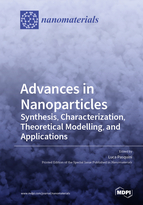Advances in Nanoparticles: Synthesis, Characterization, Theoretical Modelling, and Applications
A special issue of Nanomaterials (ISSN 2079-4991).
Deadline for manuscript submissions: closed (20 December 2018) | Viewed by 38793
Special Issue Editor
Interests: nanoparticles; alloys; grain boundaries; nanostructured materials; hydrogen storage; magnesium; material characterization; X-ray diffraction; microstructure
Special Issues, Collections and Topics in MDPI journals
Special Issue Information
Dear Colleagues,
Recent advances in the synthesis of nanoparticles (NPs) and in atomic-scale characterization, coupled with insights from theoretical modelling, have opened up exciting possibilities to tailor knowledge-based NPs for many applications, such as catalysis, plasmonics, sensors, magnetism, and nanomedicine.
The number of scientific papers with "nanoparticle" as a keyword has increased almost linearly in the last ten years, from about 13,000 in 2006 to about 46,000 in 2016. This impressive worldwide interest stems from the striking scientific appeal of nanoparticles (NPs), which constitute a bridge between the atomic and bulk worlds, as well as from their actual or potential applications in fields as diverse as catalysis, optics, magnetism, drug delivery. The preparation of NPs is a crossroad of materials science where chemists, physicists, and engineers frequently meet, leading to a continuous improvement of existing techniques and to the invention of new methods.
This symposium, L: Advances in nanoparticles: synthesis, characterization, theoretical modelling, and applications will be held 18–21 September, 2018, at the Warsaw University of Technology, Poland. It will bring together leading experts on advanced techniques for nanoparticle synthesis, in order to promote cross fertilization and to inspire progresses in the control of nanoparticle size, shape, composition and functionalization as well as in the fabrication of NPs with complex morphologies. Characterization techniques with high spatial resolution, spectroscopic capability and chemical sensitivity are an essential tool not only to investigate the output of the synthesis procedures but also to elucidate the structure-property relationships of the NPs. For this reason, this symposium will see the participation of leading experts in state-of-the-art characterization techniques for NPs structural/chemical analysis. This interdisciplinary forum will be completed by the attendance of renowned experts in theoretical modelling and simulation of NPs structure and properties, which is of paramount importance both for the understanding of the atomic and electronic structure and for the prediction of non-trivial behaviors and new phenomena. The symposium will pay particular attention to new directions in technological applications of NPs.
Prof. Dr. Luca Pasquini
Guest Editor
Manuscript Submission Information
Manuscripts should be submitted online at www.mdpi.com by registering and logging in to this website. Once you are registered, click here to go to the submission form. Manuscripts can be submitted until the deadline. All submissions that pass pre-check are peer-reviewed. Accepted papers will be published continuously in the journal (as soon as accepted) and will be listed together on the special issue website. Research articles, review articles as well as short communications are invited. For planned papers, a title and short abstract (about 100 words) can be sent to the Editorial Office for announcement on this website.
Submitted manuscripts should not have been published previously, nor be under consideration for publication elsewhere (except conference proceedings papers). All manuscripts are thoroughly refereed through a single-blind peer-review process. A guide for authors and other relevant information for submission of manuscripts is available on the Instructions for Authors page. Nanomaterials is an international peer-reviewed open access semimonthly journal published by MDPI.
Please visit the Instructions for Authors page before submitting a manuscript. The Article Processing Charge (APC) for publication in this open access journal is 2900 CHF (Swiss Francs). Submitted papers should be well formatted and use good English. Authors may use MDPI's English editing service prior to publication or during author revisions.
Keywords
- Nanoparticles, Quantum dots, Carbon nanostructures, Nanocomposites, Nanoalloys, Porous materials
- Synthesis methods (physical and chemical)
- Catalysis, Optical properties, Electronic properties, Magnetism, Nanomedicine, Imaging, Photocatalysis, Energy conversion and storage
- High-resolution characterization, Electron microscopy, Spectroscopic and scattering techniques







